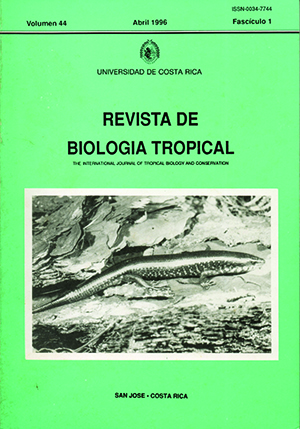Abstract
The root growth of Gliricidia sepium recently established cuttings, was studied during ten months at Ciudad Colón de Mora, Costa Rica. They were planted (following local practice) on a colluvio-alluvial soil, at Ix l m and 40 cm deep. Every month, five cuttings were extracted randomly to determine the numher and diameter of roots at 10 cm from base, numher of branches and biomass. Leaf flushing hegan two weeks after planting, while the first roots (less than 3 cm long) were observed in 40% of the cuttings after a month. Leaf biomass was higher when compared with stems and roots, except in March-April. The maximum average biomass growth rates occurred during the dry season hetween January and March, reaching values of 0.14 (SD 0.17), 0.18 (0.29) and 0.06 (0.08) g dry weightldaylcutting for leaves, branches and roots, respectively. These values dropped in April, especially for leaves and branches. No flowers were produced. The ecomorphophysiological unit of adult plants, necessary for an adequate adjustment to the environmental conditions of the site, was not reached by these cuttings.##plugins.facebook.comentarios##

This work is licensed under a Creative Commons Attribution 4.0 International License.
Copyright (c) 1996 Revista de Biología Tropical
Downloads
Download data is not yet available.


